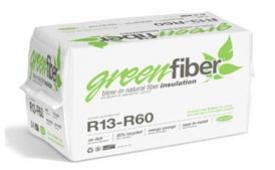Recycled Cellulose Insulation

Cellulose insulation is an environmental double whammy -- a recycled energy saver. It uses recycled newspaper fibers to make a foam-like material that cuts energy usage and costs. The foam is typically blown into attics, as either the first layer of insulation or additional layers. It acts as a heat block, keeping warm air inside during the winter and outside during the summer. Cellulose insulation also can be added in walls without existing insulation, or under floors.
Why choose recycled cellulose insulation for your home? Read about its pros and cons.
Personal Benefits
- Cellulose insulation is healthier than some alternatives. Fiberglass is a skin irritant and it may emit formaldehyde. Dense polyurethane foam is constructed with fossil fuels, and is toxic during installation.
- Cellulose insulation provides more insulation per square inch than standard fiberglass insulation. In some situations, cellulose may be more cost-effective.
- Blown-in insulation can insulate small spaces and gaps that are hard to reach or cannot be properly covered with fiberglass batts.
Environmental Benefits
- Cellulose insulation manufacturing is relatively simple, requiring few inputs and little production energy.
- Cellulose has more recycled content than other insulation products. It is generally 80 percent recycled newsprint and 20 percent non-toxic fire retardants.
- Leftover scrap can be recycled, unlike fiberglass and other insulation types.
- Greenfiber and other companies rely on local materials and only ship to local areas from each factory, which reduces energy costs for transportation.
Risks
Newspaper is very flammable, but the insulation is treated with fire retardant. Still, cellulose insulation can be a safety hazard. When thick cellulose insulation settles on a recessed light fixture, it traps the heat and could start a fire.
The simple solution is doing some prep work in the attic. Install 10 inches of flashing around light fixtures to keep the insulation away from the heat. Also put chutes around attic vents to ensure proper ventilation. For convenience, mark off the attic entry hatch with a cardboard frame to make sure you fill around the hatch without covering it.
What You'll Need
Greenfiber is the leading maker of recycled cellulose insulation. Home improvement stores sell Greenfiber insulation bags for less than $15. Greenfiber has a calculator to determine specific project needs, but a bag fills about 12 square feet of uninsulated attic space to an insulation value of R-49 (the federal suggested minimum for attics in most of the United States).
Stores typically rent blowers for do-it-yourself jobs. Two people can fill an attic with insulation in a weekend (one person runs the machine while the other holds the hose and blows in the foam). You may also hire a contractor to blow in cellulose insulation.
Photo credit: Greenfiber
Updated October 21, 2018.
Looking for a Pro? Call us (866) 441-6648

Heating & cooling Average Costs
HVAC Contractors Experiences

Desperate For New Air Conditioning On A Hot, Humid July Weekend

Blown Away By A Lovely, Affordable Handyman -- In New York City!



